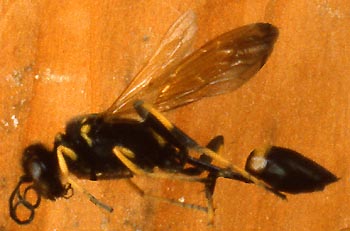
BUG OF THE MONTH: July 1996
The Black & Yellow Mud Dauber
Sceliphron caementarium
Order Hymenoptera, family Sphecidae
Copyright © 1996 by Louise Kulzer
This article originally appeared in Scarabogram, July 1996, New Series No. 195, pp. 2-3.
 |
| S. caementarium female © Rod Crawford |
You probably know the mud dauber from a combination of its striking, petiolate abdomen and its black and yellow coloration. Or you may know it from the distinctive mud cells it constructs in and around human habitations. Or from its habit of frequenting mud puddles - or hunting spiders. However you know it, Sceliphron is a notable bug.
Although I think of mud daubers as wasps, all sphecids are more closely related to bees than to the vespid wasps (Ross & Matthews 1991). There are two genera and only five species of mud daubers in the U.S. In the west, there are only two species: Sceliphron caementarium, our hero, and the blue mud dauber, Chalybion californicum, which has a blue metallic body and bluish wings (Bohart & Menke 1976). Strictly speaking, the blue mud dauber, Chalybion, doesn't really carry mud. It does, however, carry water and re-engineer abandoned cells left by Sceliphron (Bohart & Menke). Chalybion also uses plant stems and cavities for nests. An opportunist, one might say.
Mud daubers make use of spiders to provision their cells: Sceliphron uses crab spiders, orbweavers and jumping spiders in particular (Evans & West-Eberhard 1970). [In the Seattle area in late summer, the dominant prey is often the non-native cross orbweaver Araneus diadematus (Crawford 1987). On the other hand Chalybion tends to take ground-dwelling species like wolf spiders and funnel weavers.] Only one egg is laid per cell. A relatively large amount of energy is spent on each offspring, each cell being provisioned with multiple spiders.
As some of you might have suspected from the above information, mud daubers have a relatively low reproductive rate, and are K-selected species. Females average about 15 eggs over their entire life span. Considering many species are tropical, that's a modest outpouring.

Although considerable time is spent provisioning cells, mud daubers do not usually stay on the nest at night, but fly to nearby bushes or structures to sleep. Now here's the cool stuff. The blue mud dauber, Chalybion, has been observed from time to time to form sleeping aggregations. One such aggregation was reported in a cow shed in 1916. No aggregations have been reported for Sceliphron - the 1916 reference reported Sceliphron as sleeping individually on elderberry bushes (Rau 1916). Not much has been reported since then.
That is, until now! After the Ravenna Park Scarabs meeting on June 14, Scarab Collman and I were checking out weevils at the Montlake fill, when lo! we stumbled upon a sleeping aggregation of Sceliphron! Yes sir, right there before our eyes in our flashlight beams. There were about a dozen individuals under an arching blackberry branch.
So, I ask you, is entomology alive or what? Here's a behavior never before reported for this common species of mud dauber. Now all we have to do is figure out what triggers aggregation. How they mark and re-find the site each night. Where they go during the day. What their home range is. How the population changes over the summer.
One thing we do know. Early in the evening, about 9:00 PM or so, they aren't really sound asleep yet and can be disturbed rather easily. Shhhhh!
References
Bohart, R.M., and A.S. Menke. 1976. Sphecid Wasps of the World: a Generic Revision. University of California Press.
Crawford, R.L. 1987. Spider prey of the mud-dauber, Sceliphron caementarium (Sphecidae), in Washington. Proceedings of the Washington State Entomological Society, 48: 797-800.
Evans, H.E., and M.J.West-Eberhard. 1970. The Wasps. University of Michigan Press.
Howard, L.O. 1903. The Insect Book. Doubleday.
Rau, Phil. 1916. The sleep of insects. Annals of the Entomological Society of America, 9: 227-275.
Ross, K., and R. Matthews. 1991. The Social Biology of Wasps. Chapter 17, Evolution of Social Behavior in Sphecid Wasps, pp. 570-602.
This page last updated 26 July, 2005